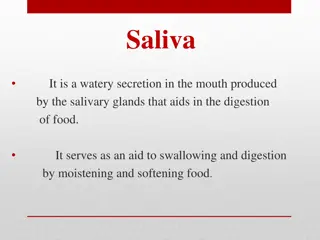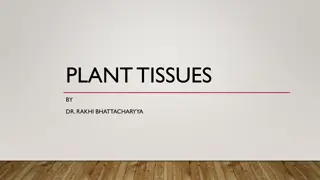Glandular Specialized Epithelium and Glands
Glandular specialized epithelium forms a class of epithelial tissues with specific functions and structures, composed of cuboidal, columnar, and ciliated columnar epithelial cells. These tissues contain gland cells that are secretary in nature, with zymogen granules in the cytoplasm. Glands are spec
1 views • 35 slides
Glandular Epithelium and Secretory Cells
Glandular epithelium consists of epithelial cells specialized in producing and secreting various macromolecules, found in glands throughout the body. These secretory cells can synthesize proteins, lipids, and carbohydrates, with different types of glands such as exocrine and endocrine glands. The se
1 views • 13 slides
Secretory Functions of the Alimentary Tract
This content delves into the secretory functions of the alimentary tract, focusing on the secretion of saliva and the role of mastication. It covers the anatomy of salivary glands, composition of saliva, control of secretion by the nervous system, and the functions of saliva in lubrication, protecti
1 views • 30 slides
Dairy Farming: Udder Anatomy and Milk Production
Exploring the external and internal anatomy of the udder in dairy cattle, including the functions of teats, streak canal, gland cistern, and supernumerary teats. Learn about milk retention, milking procedures, secretory tissue, and more crucial aspects of dairy farming.
1 views • 35 slides
Chronic Diarrhea: Causes and Consequences
Chronic diarrhea is characterized by persistent loose, watery stools lasting more than 14 days. The condition can be caused by various factors such as osmotic, secretory, inflammatory, or motility disorders. In developing countries, it often follows acute infections, while in developed countries, un
0 views • 71 slides
Epithelial Tissues: Structure and Function
Epithelial tissues play crucial roles in the human body, covering surfaces, lining cavities, and forming glands. They are highly cellular and rest on a basement membrane, separating them from connective tissues. Epithelial tissues serve functions such as protection, absorption, secretion, and contra
0 views • 15 slides
Respiratory Tract Anatomy Overview
The respiratory tract anatomy includes various structures like mucosa, submucosa, and adventitia in the trachea, bronchi, bronchioles, and terminal bronchioles. Each component has specific compositions and functions, ranging from respiratory epithelium to smooth muscle layers. The images provide a v
0 views • 15 slides
Saliva and Salivary Glands in Digestion Process
Saliva is a watery secretion produced by salivary glands in the mouth, aiding in food digestion, swallowing, and moistening food. Human salivary glands include parotid, submaxillary, and sublingual glands, each producing different types of secretions. The glands are made up of secretory acini and du
0 views • 29 slides
Plant Tissues and Meristems in Botany
Plant tissues are groups of cells with similar structures and functions. They can be classified into meristematic, permanent, and secretory tissues. Meristems are regions of continuous cell division found in plant tips and cambium, essential for growth. Primary meristems are present from the embryo
0 views • 28 slides
ANS Pharmacology: General ANS Pharmacology: General
The autonomic nervous system (ANS) plays a crucial role in controlling visceral functions below the level of consciousness. It regulates activities of secretory glands, smooth muscles, and visceral organs without voluntary control. The ANS is divided into sympathetic and parasympathetic divisions, e
0 views • 23 slides
Chronic Diarrhea and Malabsorption
Chronic diarrhea, lasting more than four weeks, can occur in up to 5% of the population. It is a symptom that may indicate various conditions affecting the gut's fluid secretion and motility. The gut absorbs fluid but may expel unwanted material in response to infections or toxins, leading to diarrh
0 views • 49 slides
Glands: Types, Classification, and Functions
Glands are specialized groups of cells that synthesize and secrete substances or hormones. They are derived from epithelium and classified based on the manner of secretion, branching pattern of duct, shape of secretory unit, and nature of secretions in exocrine glands. Explore the different types of
0 views • 11 slides











